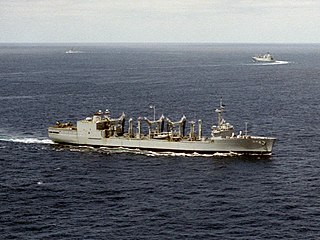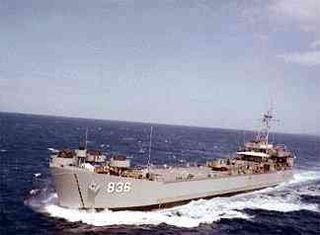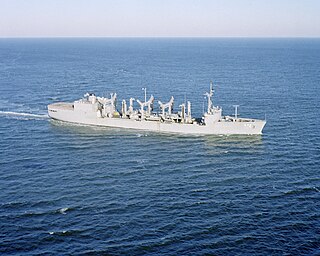
USS Ponchatoula (AO-148) was one of six Neosho-class fleet oilers built for the United States Navy, in service from 1956 to 1992, and named for the Ponchatoula Creek which rises in Tangipahoa Parish, Louisiana, and flows into the Natalbany River, west of Ponchatoula, Louisiana. She was the second U.S. Naval vessel to bear the name.

USS Gilbert Islands (CVE-107) was a Commencement Bay-class escort carrier of the United States Navy.

HMS Intrepid (L11) was one of two Fearless-class amphibious warfare ships of the Royal Navy. A landing platform dock (LPD), she served from 1967 until 1999. Based in HM Naval Base, Devonport, Plymouth, Devon and HM Naval Base Portsmouth, she saw service around the world over her 32-year life.

USS Shasta (AE-33) was a Kilauea-class replenishment ammunition ship of the United States Navy. She was named after Mount Shasta, a volcano in the Cascade Range in northern California. Shasta's mission was to support forward deployed aircraft carrier battle groups, which she accomplished through underway replenishment and vertical replenishment. Over three decades, Shasta and her crew took part in the Vietnam War, the Cold War, the Iran–Iraq War, Desert Shield/Operation Desert Storm, and numerous other actions.

USS English (DD-696) was an Allen M. Sumner-class destroyer. She was named for Rear Admiral Robert Henry English, a submariner who commanded the cruiser Helena and was awarded the Navy Cross and the Navy Distinguished Service Medal. English died in the crash of Pan Am Flight 1104 on January 21, 1943.

USS Samuel N. Moore (DD-747), an Allen M. Sumner-class destroyer, is the only ship of the United States Navy to be named for Samuel N. Moore.

The ships of the F120 Köln class of frigates were the first major warships built in Germany after World War II.

USS Gurke (DD-783) was a Gearing-class destroyer of the United States Navy, in service from 1945 to 1976. She was transferred to Greece in 1977 and served as Tombazis until 1997.

The Cyclone-class patrol ships are a class of United States Navy coastal patrol boats. Most of these ships were launched between 1992 and 1994. The primary mission of these ships is coastal patrol and interdiction surveillance, an important aspect of littoral operations outlined in the Navy's strategy, "Forward...From the Sea." These ships also provide full mission support for U.S. Navy SEALs and other special operations forces.

USS Kalamazoo (AOR-6) was a Wichita-class replenishment oiler commissioned by the U.S. Navy in 1973. She continued to support Navy requirements until 1996 when she was placed in the reserve fleet and later struck.
HMS Kingfisher (P260) was a Bird-class patrol vessel of the British Royal Navy.

USS Wabash (AOR-5) was a Wichita-class replenishment oiler in the United States Navy from 1970 to 1994.

USS Savannah (AOR-4), was a Wichita-class replenishment oiler of the United States Navy. The fifth Savannah was laid down on 22 January 1969 by the General Dynamics Quincy Shipbuilding Division at Quincy, Massachusetts, launched on 23 April 1970, sponsored by Mrs. Ralph L. Shifley, wife of Vice Admiral R. L. Shifley, Deputy Chief of Naval Operations, and commissioned on 5 December 1970, Capt. Bernard P. Williams, Jr., in command.

USS Holmes County (LST-836) was an LST-542-class tank landing ship built for the United States Navy during World War II. Named after counties in Florida, Mississippi, and Ohio, she was the only U.S. Naval vessel to bear the name.

USS Cimarron (AO-177) was the lead ship of the Cimarron-class of fleet oilers of the United States Navy. Cimarron was built at the Avondale Shipyards in New Orleans, Louisiana (USA) starting in 1978 and was commissioned in 1981 for service in the Pacific Fleet. Commissioned 10 January 1981, in Oakland, California. The oiler was home ported in Pearl Harbor, Hawaii. Total cost for the ship was $136.7 million.

Wichita-class replenishment oilers comprised a class of seven replenishment oilers used by the United States Navy from the late 1960s to the mid-1990s. The ships were designed for rapid underway replenishment using both connected replenishment and vertical replenishment.

The Sparviero-class, also known as Nibbio-Class, are small hydrofoil missile boats capable of traveling at speeds of 46 knots. They were designed for and formerly used by the Italian Navy. The Japanese 1-go class missile boat is an updated version formerly used by the Japan Maritime Self-Defense Force (JMSDF).

USS Milwaukee (AOR-2) was a Wichita-class replenishment oiler commissioned by the U.S. Navy in 1969. She continued to support Navy requirements until 1994 when she was placed in the reserve fleet and later struck.

USS Roanoke (AOR-7) was a Wichita-class replenishment oiler of the United States Navy. She was named after the city of Roanoke, Virginia and the Roanoke River, in keeping with the naming convention of her class.

HSwMS Älvsborg (M02) was a minelayer in the Swedish Navy, launched on 11 November 1969. She had one sister ship, HSwMS Visborg. She belonged to the 1st Submarine Flotilla and served as leader of the division. In 1997, Älvsborg was sold to Chile and was renamed Almirante José Toribio Merino Castro. She was taken out of service on 15 January 2015.



















